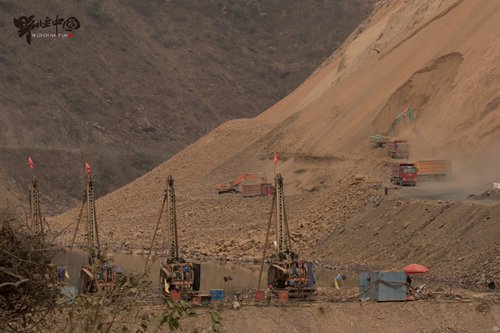
Workers construct the Jiasajiang Level 1 Hydropower Station on the Red River bordering Shuangbai and Xinping counties in Yunnan Province. (Photo/Wild China Film)

A green peafowl snapped by the Wild China team on a recent visit to the Jiasajing dam area (Photo/Wild China Film)
The area that will be flooded by the dam's reservoir is home to many other rare species, such as the cycas chenii, a new plant that was first discovered in China in 2015 and brown fish owls, according to the letter that has been released to the public.
The three organizations made a joint application on April 10 to the MEP, the Ministry of Water Resources, the Chuxiong government and the China Renewable Energy Engineering Institute which approved the Jiasajiang station's feasibility report, asking for all the information about the environmental impact of the station.
"However, we have received no reply yet. I don't know if it's progress or a setback," Xi remarked at the lecture, comparing the authorities' behavior to the quick replies given by senior officials to his letter concerning the Yunnan snub-nosed monkey in 1995.
A former postgraduate student at the Chinese Academy of Sciences who has studied the vegetation and biodiversity along rivers in Yunnan told the Global Times on the condition of anonymity that the station will undoubtedly threaten the best preserved regions along the Red River. "The peafowl may leave and search for a new home, but the flora can't," he noted.
The Jiasajiang Level 1 Power Station on the Red River is located on border of Shuangbai and Xinping. It was listed as a key project by the Yunnan provincial government in 2015. The dam will be 175 meters high and the installed capacity will be 270,000 kilowatts, according to local newspaper the Chuxiong Daily.
Apart from generating power, advocates of the station purport it will also help irrigate farmland and provide water for downstream urban centers, the newspaper reported. Clearance and landscaping work is planned to be launched in November, the first generator is scheduled to come into operation in August 2020 and the others should come into operation later that year.
Xi and his fellow investigators also found that several other dams have already been built along the tributaries of the Red River, a fact which has not been publicized by the local government or widely reported on by the local media. The dams have brought roads to the deep mountains, as well as tourists and investors.
But not all the locals welcome the changes. "Some farmers living downstream found irrigation actually became harder," said one investigator who requested anonymity. "Some were displeased as they were not properly compensated for the land acquisition."
The anonymous postgraduate made a trip to the region recently and found work on the Jiasajiang Level 1 Power Station hasn't been affected by outside concerns and protests. He said many power stations in Yunnan are idle most of the time due to water shortages or power surplus.
The Global Times' calls and texts to local Party chiefs and the directors of nature reserves near the station all went unanswered.
The Yunnan Forestry Department responded quickly however. It organized a two-day investigation trip to Xinping and Shuangbai in late March and drafted a statement declaring that it will supervise the local authorities and station's builders to minimize their impact and protect or set up a new reserve for the peafowl.
Hydropower station mania?
The hydropower resources in Yunnan, which is home to more than 600 rivers, are ranked second out of China's provincial-level regions. Hydropower has become a major pillar industry of the province.
In 2003, the provincial government issued a document encouraging local governments to quickly develop small- and mid-sized hydropower projects and allowed prefecture-level governments to approve stations with a capacity below 250,000 kilowatts.
Many investors from Jiangsu, Zhejiang and Sichuan provinces were attracted by these liberalizations and many small dams were built one after another. According to a 2011 report by the Xinhua News Agency, there were then a total of 5,572 dams in the province.
This development mania has brought tax income and growth, as well as a power surplus. Many small hydropower station investors have found it difficult to turn a profit, according to a report by the Southern Weekend magazine in August last year.
The Yunnan Power Grid estimated that the province's total annual power generating capacity would surpass 300 billion kilowatts by the end of last year, but its total demand last year was only 210 billion kilowatts.
The proliferation of cascade-type hydropower stations has also allegedly caused huge environmental damage. According to comparisons of satellite and aerial images over time, the flow of water in some major rivers has shrunk and the balance of valley ecosystems has been broken, lamented the anonymous postgraduate.
"On many occasions, local officials care only about economic benefits, but little about the ecological impact," he said. He revealed that to easily obtain approval for dams, investors and local governments usually falsify documents or downplay their environment impact.
In July last year, Yunnan announced a brake on these developments, banning the construction of new small- and mid-sized hydropower plants.
There are already three power stations along the Chinese stretches of the Red River that flows from Yunnan through Vietnam before emptying into the Gulf of Tonkin, and eight more are now planned, according to the anonymous scholar.
Zhang from Friends of Nature said that the three organizations have organized a team to survey all Yunnan's major rivers to comprehensively assess the riverside environment and biodiversity. "Besides, we are trying to communicate with local governments and hope to reach out a satisfactory solution," he added.


















































